In selecting articles for the first section, the editors first searched for historical press materials covering Jeju through various online portals. Although contemporaneous reporting on the massacre was sparse, the most illustrative examples have been selected and displayed as press clippings with headlines, subheadings and key passages. The articles were all published between 1948 and 1949 with three, half the selected total, written by The New York Times war correspondent Richard J. H. Johnston. United Press provides the remaining three articles, which were published respectively in The New York Times, The Washington Post and The Los Angeles Times. The articles provide a window into how the conflict was viewed by the US military government of the time. The uncritical assumptions about “reds” and “communists,” for example, reflect the McCarthyist atmosphere of the early Cold War years. It is important to note that this picture of a just, if brutal, crackdown upon communist guerillas was not effectively challenged until democratization in 1987.
Help Rushed to Quell Red Riots on Korean Island
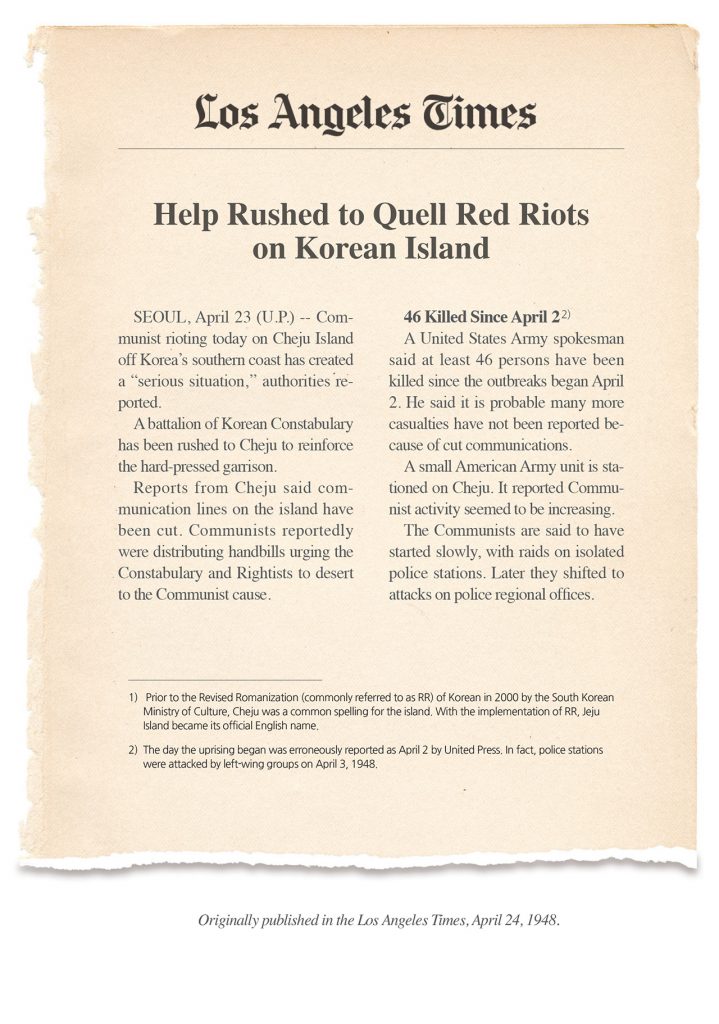
SEOUL, April 23 (U.P.) — Communist rioting today on Cheju¹ Island off Korea’s southern coast has created a “serious situation,” authorities reported.
A battalion o! Korean Constabulary has been rushed to Cheju to reinforce the hard-pressed garrison.
Reports from Cheju said communication lines on the island have been cut. Communists reportedly were distributing handbills urging the Constabulary and Rightists to desert to the Communist cause.
46 Killed Since April 2²
A United States Army spokesman said at least 46 persons have been killed since the outbreaks began April 2. He said it is probable many more casualties have not been reported because of cut communications.
A small American Army unit is stationed on Cheju. It reported Communist activity seemed to be increasing.
The Communists are said to have started slowly, with raids on isolated police stations. Later they shifted to attacks on police regional offices.
1 Prior to the Revised Romanization (commonly referred to as RR) of Korean in 2000 by the South Korean Ministry of Culture, Cheju was a common spelling for the island. With the implementation of RR, Jeju Island became its official English name.
2 The day the uprising began was erroneously reported as April 2 by United Press. In fact, police stations were attacked by left-wing groups on April 3, 1948.
Originally published in the Los Angeles Times, April 24, 1948.
Korea Police Raid Strife-torn City
60 Suspected Agitators Taken in Cheju After Series of Fatal Disturbances
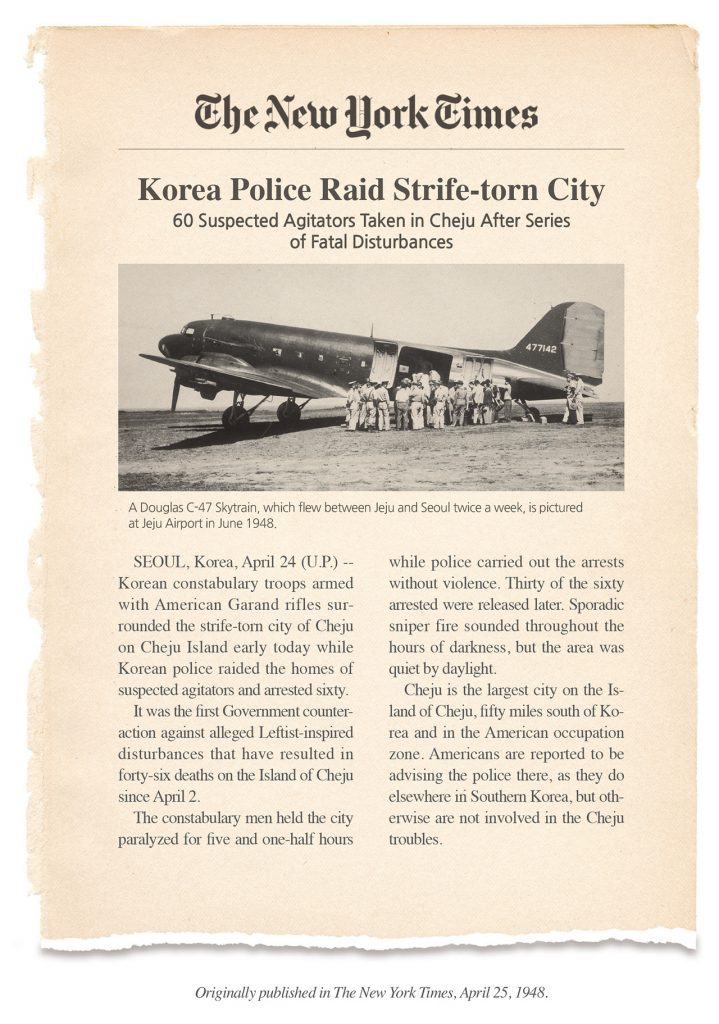
SEOUL, Korea, April 24 (U.P.) — Korean constabulary troops armed with American Garand rifles surrounded the strife-torn city of Cheju on Cheju Island early today while Korean police raided the homes of suspected agitators and arrested sixty.
It was the first Government counter-action against alleged Leftist-inspired disturbances that have resulted in forty-six deaths on the Island of Cheju since April 2.
The constabulary men held the city paralyzed for five and one-half hours while police carried out the arrests without violence. Thirty of the sixty arrested were released later. Sporadic sniper fire sounded throughout the hours of darkness, but the area was quiet by daylight.
Cheju is the largest city on the Island of Cheju, fifty miles south of Korea and in the American occupation zone. Americans are reported to be advising the police there, as they do elsewhere in Southern Korea, but otherwise are not involved in the Cheju troubles.
Originally published in The New York Times, April 25, 1948.
Small War Rages on Korean Island
Communists on Cheju Attack Villages, Demand Police Surrender, No Election
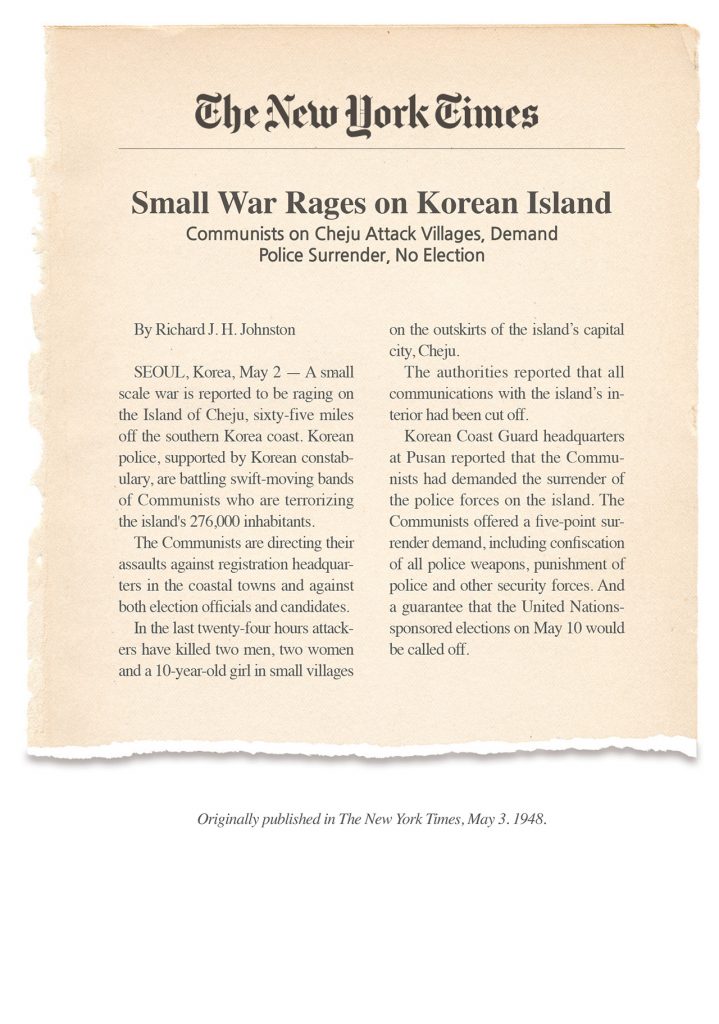
By Richard J. H. Johnston
—
SEOUL, Korea, May 2 — A small scale war is reported to be raging on the Island of Cheju, sixty-five miles off the southern Korea coast. Korean police, supported by Korean constabulary, are battling swift-moving bands of Communists who are terrorizing the island’s 276,000 inhabitants.
The Communists are directing their assaults against registration headquarters in the coastal towns and against both election officials and candidates.
In the last twenty-four hours attackers have killed two men, two women and a 10-year-old girl in small villages on the outskirts of the island’s capital city, Cheju.
The authorities reported that all communications with the island’s interior had been cut off.
Korean Coast Guard headquarters at Pusan reported that the Communists had demanded the surrender of the police forces on the island. The Communists offered a five-point surrender demand, including confiscation of all police weapons, punishment of police and other security forces. And a guarantee that the United Nations-sponsored elections on May 10 would be called off.
The authorities reported that all communications with the island’s interior had been cut off.
Korean Coast Guard headquarters at Pusan reported that the Communists had demanded the surrender of the police forces on the island. The Communists offered a five-point surrender demand, including confiscation of all police weapons, punishment of police and other security forces. And a guarantee that the United Nations-sponsored elections on May 10 would be called off.
Originally published in The New York Times, May 3. 1948.
Communist Terrorism Marks Election in Southern Korea
39 Dead, 17 Hurt, 142 Held
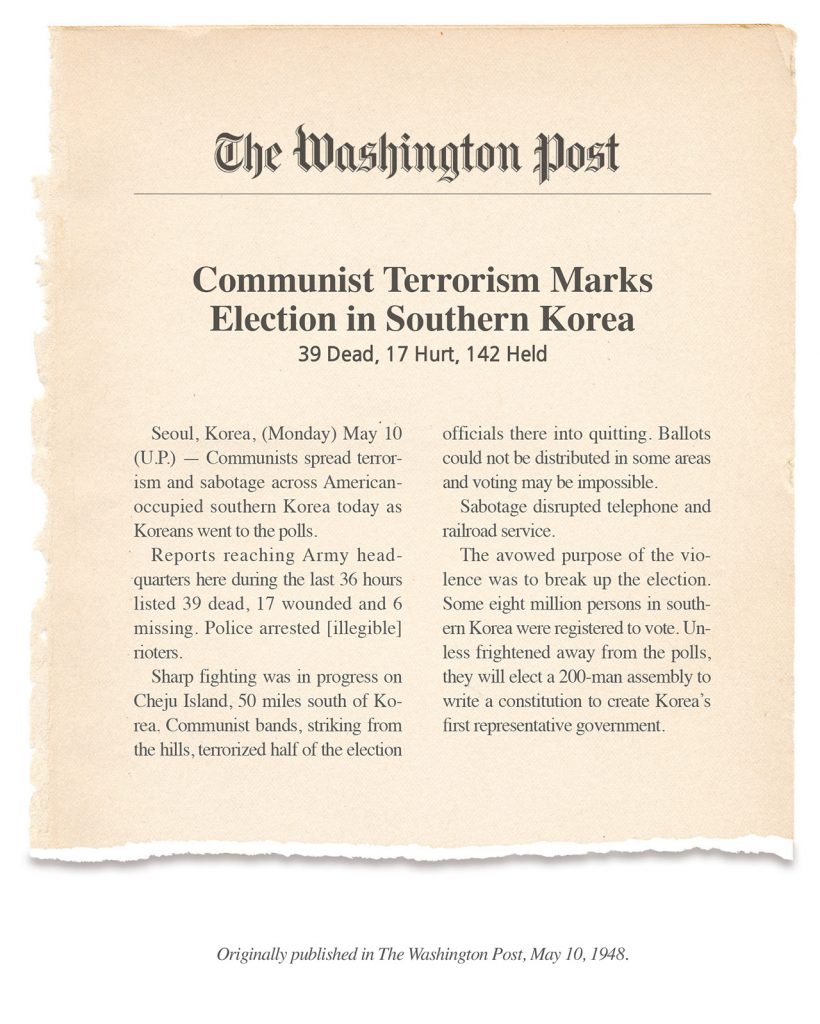
Seoul, Korea, (Monday) May 10 (U.P.) — Communists spread terrorism and sabotage across American-occupied southern Korea today as Koreans went to the polls.
Reports reaching Army headquarters here during the last 36 hours listed 39 dead, 17 wounded and 6 missing. Police arrested [illegible] rioters.
Sharp fighting was in progress on Cheju Island, 50 miles south of Korea. Communist bands, striking from the hills, terrorized half of the election officials there into quitting. Ballots could not be distributed in some areas and voting may be impossible.
Sabotage disrupted telephone and railroad service.
The avowed purpose of the violence was to break up the election. Some eight million persons in southern Korea were registered to vote. Unless frightened away from the polls, they will elect a 200-man assembly to write a constitution to create Korea’s first representative government.
Originally published in The Washington Post, May 10, 1948.
Drive Upon Rebels is Opened in Korea
Army Ordered to Take or Wipe Out Communist-Led Groups That Cause Starvation
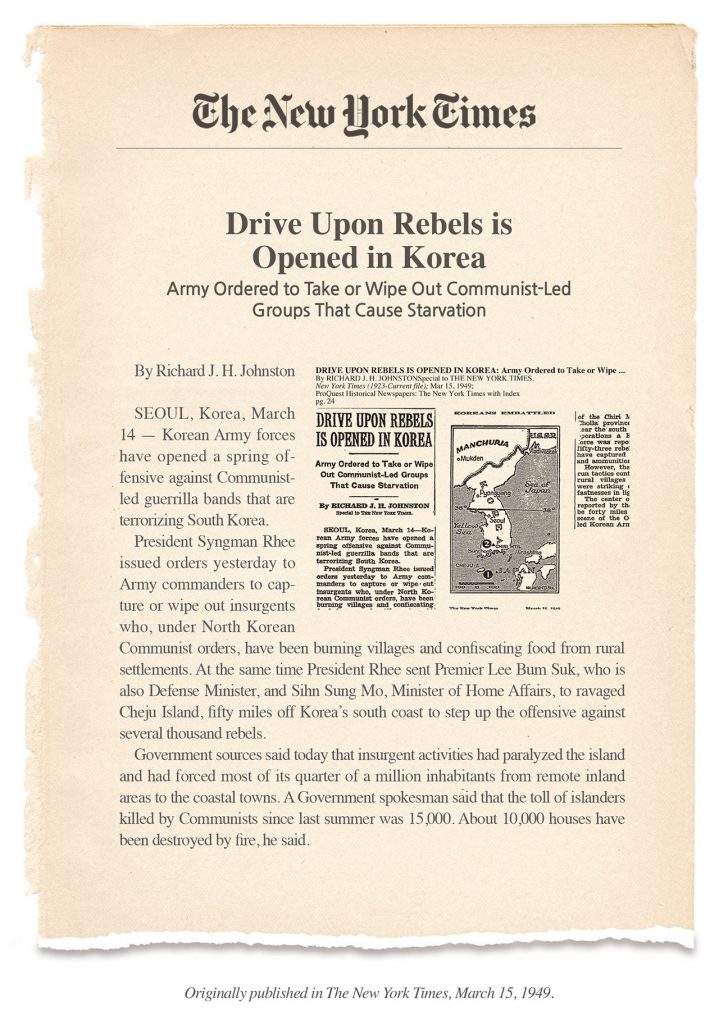
By Richard J. H. Johnston
—
SEOUL, Korea, March 14 — Korean Army forces have opened a spring offensive against Communist-led guerrilla bands that are terrorizing South Korea.
President Syngman Rhee issued orders yesterday to Army commanders to capture or wipe out insurgents who, under North Korean Communist orders, have been burning villages and confiscating food from rural settlements. At the same time President Rhee sent Premier Lee Bum Suk, who is also Defense Minister, and Sihn Sung Mo, Minister of Home Affairs, to ravaged Cheju Island, fifty miles off Korea’s south coast to step up the offensive against several thousand rebels.
Government sources said today that insurgent activities had paralyzed the island and had forced most of its quarter of a million inhabitants from remote inland areas to the coastal towns. A Government spokesman said that the toll of islanders killed by Communists since last summer was 15,000. About 10,000 houses have been destroyed by fire, he said.
Originally published in The New York Times, March 15, 1949.
Rhee Visits Scene of Korean Revolt
Flies to Cheju Island Where Police and Army Are Mopping Up Reds—15,000 Dead
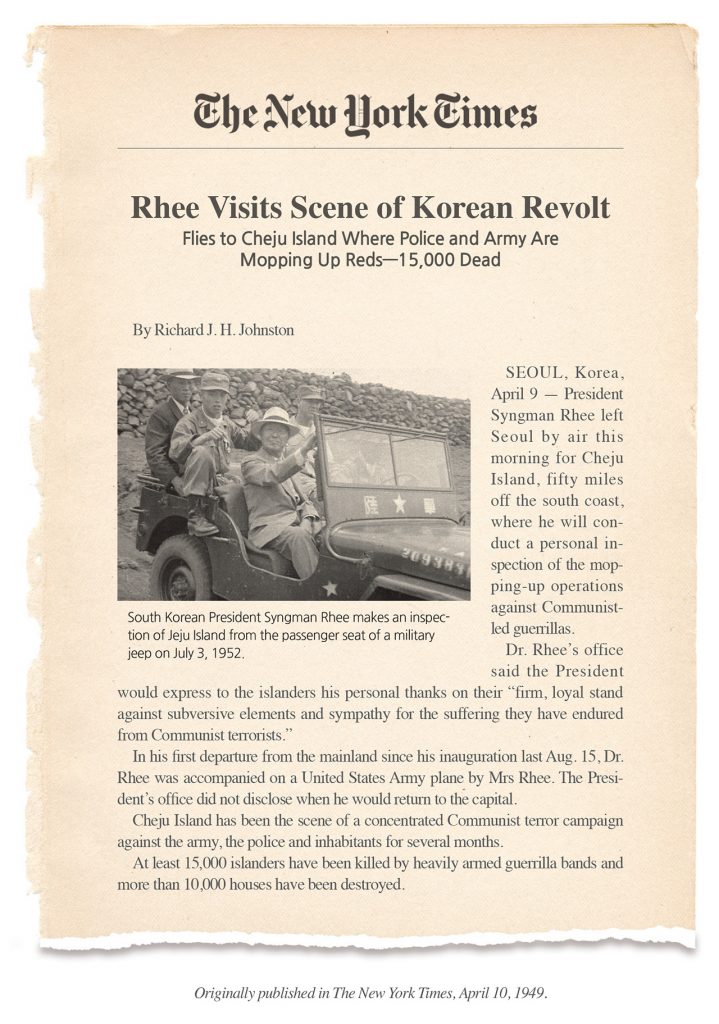
By Richard J. H. Johnston
—
SEOUL, Korea, April 9 — President Syngman Rhee left Seoul by air this morning for Cheju Island, fifty miles off the south coast, where he will conduct a personal inspection of the mopping-up operations against Communist-led guerrillas.
Dr. Rhee’s office said the President would express to the islanders his personal thanks on their “firm, loyal stand against subversive elements and sympathy for the suffering they have endured from Communist terrorists.”
In his first departure from the mainland since his inauguration last Aug. 15, Dr. Rhee was accompanied on a United States Army plane by Mrs Rhee. The President’s office did not disclose when he would return to the capital.
Cheju Island has been the scene of a concentrated Communist terror campaign against the army, the police and inhabitants for several months.
At least 15,000 islanders have been killed by heavily armed guerrilla bands and more than 10,000 houses have been destroyed.